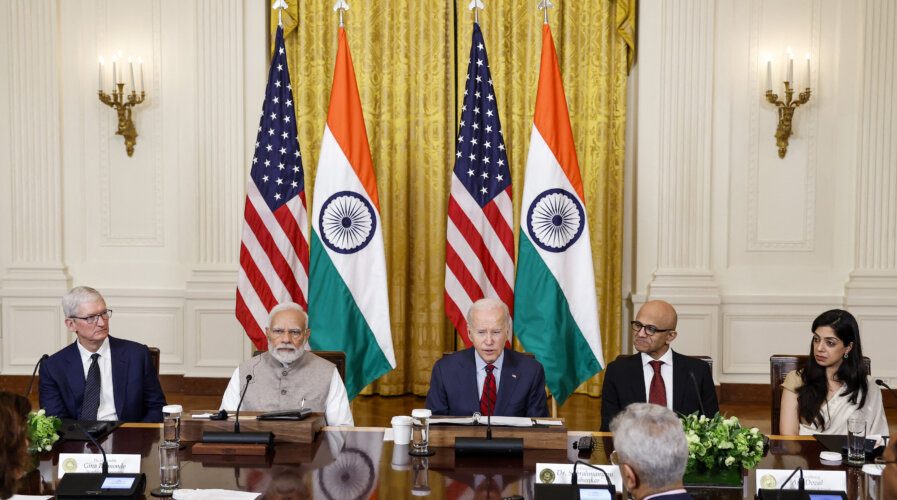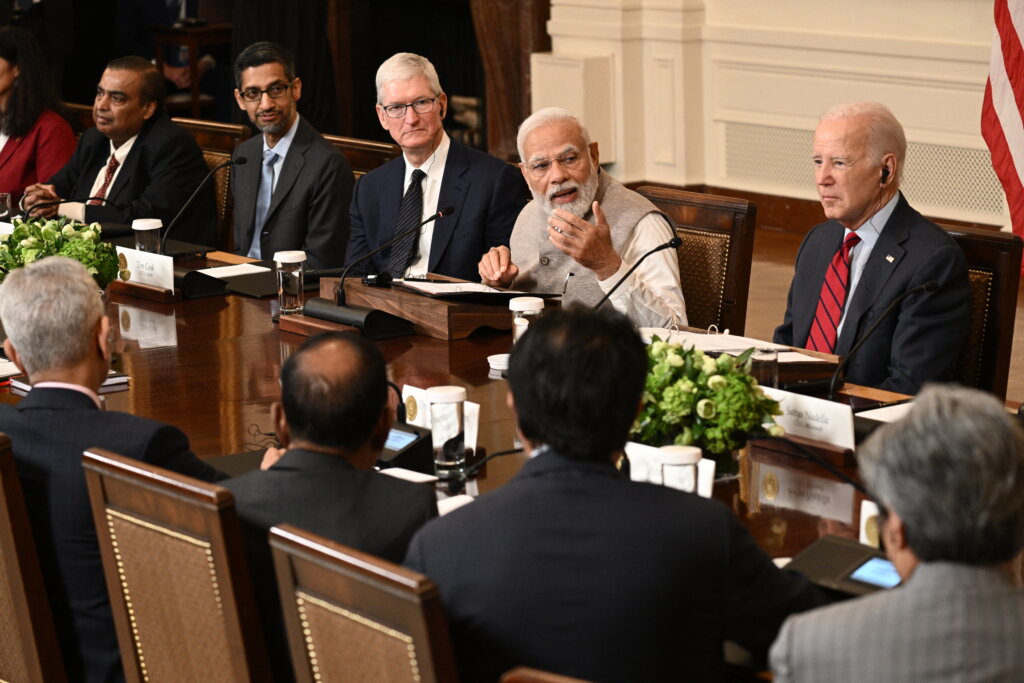
India welcomed a flurry of deals within its semiconductor industry during PM Narendra Modi’s visit to the US.(Photo by Anna Moneymaker / GETTY IMAGES NORTH AMERICA / Getty Images via AFP)
Why India is growing to be a global semiconductor hub
|
Getting your Trinity Audio player ready... |
- India welcomed a flurry of deals within its semiconductor industry during PM Narendra Modi’s visit to the US.
The ascendancy of India, especially as a global semiconductor hub, has been receiving a significant boost with the recent flurry of manufacturing deals. Leading US corporations within the semiconductor industry have been accelerating their push into the South Asian nation as an alternative production hub to China amid protracted tensions between Washington and Beijing.
Within the last two weeks alone, during Prime Minister Narendra Modi’s trip to the US, American semiconductor players, including Micron Technology, Applied Materials, and Lam Research, have announced their plans to invest in the semiconductor industry in India.
Optimism about growth has been mounting, especially following the news that Apple opened its first Indian store in Mumbai in April. To top it off, during Modi’s meeting with Tesla’s CEO in the US, Musk emphasized that his company would move into India “as soon as humanly possible.”
In short, while the ties between the US and China are wearing off, between American and Indian companies, ties are getting deeper. The Biden administration has viewed its relationship with New Delhi as a vital counterpoint to Beijing’s efforts at reshaping international dynamics.

US President Joe Biden looks on as the Prime Minister pf India Narendra Modi speaks during a meeting with senior officials and CEOs of American and Indian companies, in the East Room the White House in Washington, DC, on June 23, 2023.
(Photo by Brendan SMIALOWSKI / AFP)
Micron’s first semiconductor facility in India
Micron, an American company specializing in the manufacturing of semiconductors and memory products, said it would invest up to US$825 million in its first semiconductor assembly and test facility in India. The facility, to be built in Gujarat, will be constructed under the incentive scheme for the chip ecosystem in the country.
US based Micron Technology Inc to set up semiconductor plant in Gujarat, India.
The US chip maker became the most high-profile name to commit investment in India to build a chip packaging plant shortly after the Chinese government barred it from national projects over alleged national security risks. The new facility will also enable assembly and test manufacturing for DRAM and NAND products while addressing demand from domestic and international markets.
Micron also shared that the company will provide 5,000 direct jobs and 500 new high-end engineering jobs for the upcoming Gujarat facility. Phased construction of the new assembly and test facility in Gujarat is expected to begin sometime this year. Phase one, which will include 500,000 sq ft of planned cleanroom space, will start operating in late 2024, and Micron will ramp capacity gradually over time in line with global demand trends.
The company expects phase two of the project, which would include constructing a facility similar in scale to phase one, to start towards the second half of the decade.
Applied Materials’ engineering center in Bangalore
Known for materials engineering, providing manufacturing equipment, services, and software to the semiconductor, display, and other related industries, Applied Materials’ plan in India is priced at US$400 million. The organization will create a campus where staff will work alongside “leading global and domestic suppliers and top research and academic institutions” to develop new chip-making kits.
Micron Technology and Applied Materials’ investment news came on the same day as Modi’s state visit to Washington.
Lam Research to train 60,000 engineers in India in the next ten years
Within the same week, while Modi was still in the US, American semiconductor manufacturing equipment supplier, Lam Research, announced its plans to train 60,000 engineers in India within the next ten years. The training will be facilitated by the company’s virtual nanofabrication environment platform, Semiverse Solutions.
“Lam Research’s Semiverse Solutions with SEMulator3D will deliver a virtual nanofabrication environment to help train the next generation of semiconductor engineers in India. Combined with program management and course curriculum customization, this program is targeted to educate up to 60,000 Indian engineers in nanotechnologies, over ten years, in support of India’s semiconductor education and workforce development goals,” the company said.
Semiconductor market outlook for India
In a recent report by Counterpoint Research, the Indian semiconductor market is forecasted to witness stellar growth, with market value expected to surpass US$64 billion by 2026. For context, the chip industry was valued at US$22.7 billion in 2019, a joint report by Counterpoint Research and the India Electronics & Semiconductor Association (IESA) shows.
Counterpoint reckons domestic and export markets will drive the 2026 forecast with significant consumer electronics, telecom, IT hardware, and industrial demand. “India’s ‘telecom stack’ and industrial applications are expected to account for two-thirds of the total,” the report reads.
READ MORE
- Safer Automation: How Sophic and Firmus Succeeded in Malaysia with MDEC’s Support
- Privilege granted, not gained: Intelligent authorization for enhanced infrastructure productivity
- Low-Code produces the Proof-of-Possibilities
- New Wearables Enable Staff to Work Faster and Safer
- Experts weigh in on Oracle’s departure from adland


